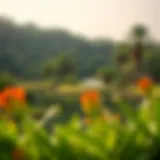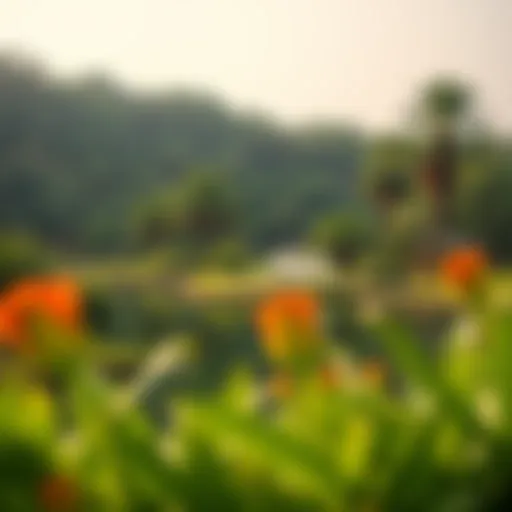Leading Builders Transforming Dubai's Skyline
Intro
Dubai has matured into a global wonder, not just because of its breathtaking architecture but also due to the relentless drive of various builders who have sculpted the skyline. In a city known for towering structures and innovative designs, understanding who is behind this transformation is crucial. Top-tier construction companies, driven by ambition and a vision for the future, have shaped not just the landscape but the economy of Dubai as well. Their work reflects not merely the aesthetic of the buildings but also the underlying trends in the real estate sector.
Real estate agents, investors, expatriates, and developers need to grasp the pivotal role these builders play. This article delves deep into the leading construction firms that are revolutionizing Dubai's skyline, exploring the innovative projects they've tackled, their strategies for sustainability, and the competitive dynamics that define the market today.
Foreword
The skyline of Dubai is nothing short of a modern marvel. In the span of just a few decades, this bustling metropolis has transformed from a modest trading post into a global architectural showcase. Central to this revolution are the builders who have played a significant role in reshaping not just the city’s landscape, but also its socio-economic fabric. The importance of focusing on the prominent builders in Dubai extends beyond merely appreciating their architectural feats.
Understanding the myriad of construction companies that have left their mark in Dubai offers insight into the intersection of innovation and tradition. These firms are not just constructors; they are visionaries who envision, design, and construct landmarks that reflect both luxury and functionality.
In this article, we’ll explore:
- The evolution of the construction industry in Dubai,
- Profiles of major construction firms that are crucial to Dubai's skyline,
- Signature projects that bind the identity of this city,
- Innovative practices that underscore sustainability in building efforts.
By delving into these aspects, readers will gain valuable perspectives on how these builders influence the real estate market and the economy at large.
Furthermore, for investors, expatriates, and future homeowners, this analysis acts as a compass, guiding them in navigating the complexities of Dubai's real estate landscape. The significance of this discussion cannot be overstated; as Dubai continues to grow and evolve, so too does the critical need for sustainable and innovative construction practices that can sustain its rapid urbanization while respecting its cultural heritage.
"The builders of Dubai not only shape its skyline but also forge its identity within the global community."
With this foundational understanding in place, let’s turn our attention to the evolution of Dubai’s construction industry, a tale steeped in ambition and transformation.
The Evolution of Dubai's Construction Industry
The landscape of Dubai is a visual narrative of ambition, innovation, and transformation. Understanding the evolution of its construction industry serves as a foundational pillar for appreciating how this vibrant city became a global icon. This evolution isn't just a sequence of events; it's a complex interplay between visionaries, regulatory frameworks, and technological advancements that have shaped the skyline into what it is today.
The Dubai construction sector represents more than mere buildings. It encapsulates socio-economic dynamics, cultural expression, and sustainability practices. By delving into the historical context and regulatory changes that have influenced this industry, stakeholders—including real estate agents, investors, expatriates, homeowners, and developers—can glean insights that help forecast future trends and opportunities.
Historical Context
Dubai's journey began as a modest trading port before it burgeoned into a bustling metropolis. In the early 20th century, the city was largely a collection of humble structures, built primarily of coral and mud. However, the discovery of oil in the 1960s marked the commencement of a construction frenzy that would lay the groundwork for the modern city we see today. Large-scale projects kicked off during this era, including infrastructure developments that were vital for catering to the growing population and diversifying the economy.
By the late 1980s and 1990s, as the city began to grow in international stature, the skyline was characterized by new architectural styles. But it wasn't until the early 2000s that the daring projects like the Burj Khalifa and Palm Jumeirah redefined not only Dubai's skyline but also its global image. The investment in construction reached unprecedented levels, with developers eager to showcase their ability to push the boundaries of what was architecturally possible.
Key Regulatory Changes
As the construction industry grew, so too did the need for structured regulations. The Dubai government recognized that for the sector to thrive sustainably, it required robust oversight. Initiatives were put in place to streamline construction processes, ensuring quality and safety standards were met.
Key regulatory changes in the past few decades include:
- Dubai Building Code: A comprehensive framework that outlines safety, design, and environmental standards, ensuring that all structures meet international standards while contributing to urban aesthetic.
- Freehold Property Law (2002): This landmark legislation allowed non-UAE nationals to purchase property in designated areas, drastically opening the market for foreign investment and participation.
- The Dubai Land Department: Established to oversee land transactions, it introduced digital solutions to make property transactions transparent and efficient.
These regulatory shifts not only reinforced trust among investors but also built a solid foundation for sustainable urban development. They encouraged local and foreign investment, positioned Dubai as a premier destination for construction and real estate opportunities, and enhanced the city's overall market appeal.
The progress in Dubai's construction industry is a testament to its resilience and adaptability. As the city evolves, so too will the regulations and standards that govern its growth, ensuring that development continues in a manner that is not just ambitious but also sustainable. The history and regulatory framework provide crucial insights into anticipating future industry trends.
Major Construction Firms in Dubai
When it comes to Dubai's skyline, the major construction firms play a pivotal role. They are the driving engines of the city’s ambitious architectural dream, crafting not just buildings but also the very identity of the metropolis. The significance of these firms extends beyond mere construction; they shape economic growth, employment opportunities, and urban planning strategies. With each project, they bring an intricate blend of innovation, sustainability, and market insight, ultimately influencing the real estate environment in the region. Understanding these companies is essential for anyone looking to invest or engage in the bustling Dubai property market.
Company Profiles
Within the ranks of Dubai's major construction firms, several stand out for their impact and contributions to the cityscape. Each company has a unique profile that reflects its business focus, market approach, and portfolio of projects.
- Emaar Properties: Known for iconic landmarks like the Burj Khalifa and The Dubai Mall, Emaar has become synonymous with luxury urban living. Their focus extends beyond residential projects; they cater to hospitality and retail sectors, shaping Dubai’s cultural landscape.
- Dubai Holding: This conglomerate oversees a diverse array of ventures, including leisure, tourism, and residential developments. Their flagship projects, such as Jumeirah Beach Residence, redefine communal living by combining recreational amenities with residential options.
- Aldar Properties: Originally rooted in Abu Dhabi, Aldar has made significant strides in Dubai with projects like Yas Island. Their developments often emphasize sustainability and community integration, reflecting a modern approach to urban planning.
- Nakheel Properties: Famous for innovative projects like Palm Jumeirah, Nakheel is pivotal in turning visionary concepts into reality. Their focus on waterfront developments has enhanced Dubai’s appeal to investors and tourists alike.
- Binladin Group: With a long-standing history in construction, this group has contributed extensively to Dubai's infrastructure. Their involvement in high-profile projects reinforces their reputation as leaders in the field, blending tradition with modernity.
Ranking Criteria
Understanding how these companies are ranked within the industry offers valuable insights into their operational success and market perception. Various criteria help paint a clearer picture, including:
- Project Portfolio: The diversity and scale of projects undertaken are primary indicators. Companies that handle iconic and landmark projects typically fare better in rankings.
- Financial Performance: This includes revenue growth, profitability, and investment returns, which are critical for assessing the company’s overall health and sustainability.
- Innovation and Technology: The adoption of new construction techniques and materials sets apart the leaders. Companies that leverage technology often create more efficient and sustainable solutions, thus gaining an edge.
- Sustainability Practices: As the world shifts towards greener building practices, firms that prioritize sustainable development in their projects are highly regarded.
- Client Satisfaction: Feedback from clients, which includes assessments on quality, timeliness, and post-project service, plays a significant role in ranking evaluations.
In summary, the major construction firms in Dubai are at the forefront of not only building structures but also creating a legacy for future generations. Their influence spans across sectors and has ramifications for investments, urban growth, and community welfare.
Emaar Properties
Emaar Properties stands as a linchpin of Dubai's architectural landscape, creating not only buildings but experiences that resonate globally. Founded in 1997, it's among the larger real estate developers in the region, known for its ambitious projects that have transformed the city into a hub of luxury and innovation. The importance of exploring Emaar lies not just in its portfolio, but also its influence on urban development and investment prospects within Dubai.
With Emaar, it’s all about pushing boundaries. This developer doesn't just build; it shapes communities and fosters lifestyles that appeal to a diverse demographic, from opulent living spaces to commercial ventures. Investors and expatriates alike see value in Emaar’s developments due to their strategic location and design excellence. As such, understanding Emaar’s overarching strategies and projects provides key insights into Dubai's dynamic real estate market.
Overview
The overview of Emaar Properties reveals its stature in international real estate. As a dominant player, the company emphasizes upscale living and integrates modern infrastructure with sustainable development practices. Emaar’s approach involves melding luxury and functionality. One striking example is how they prioritize green spaces in their projects, enhancing the quality of urban life while adhering to sustainable practices.
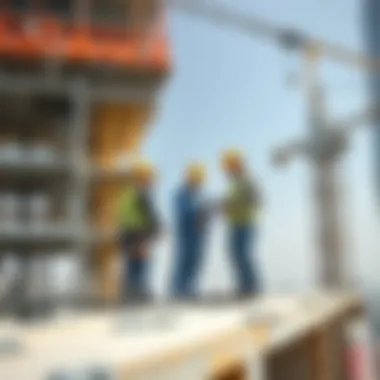
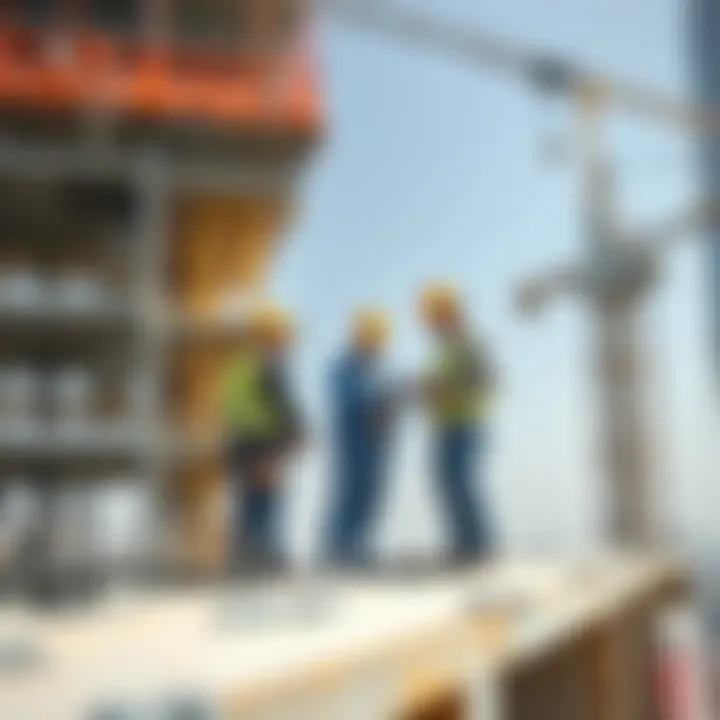
Moreover, Emaar has not only fostered residential projects but developed large-scale community-focused initiatives that include entertainment, retail, and leisure. The company's commitment to sustainability is reflected in its compliance with global environmental standards, demonstrating a clear vision of a future where urban living and nature coexist harmoniously.
Signature Projects
In its arsenal, Emaar boasts an array of signature projects that define Dubai’s skyline. Two of the most iconic are the Burj Khalifa and The Dubai Mall, symbols of innovation and luxury that showcase Emaar's capability to think big.
Burj Khalifa
Burj Khalifa is not just the tallest building in the world; it's a testament to modern engineering and architectural ambition. Standing at a staggering height of 828 meters, it redefines what structures can achieve. As a beneficial subject in this yourney, Burj Khalifa represents more than a height; it symbolizes the spirit of Dubai – ambitious and forward-looking.
The unique feature here is the mix of residential, corporate, and hospitality spaces. This multifaceted approach creates a microcosm of urban living, with all essentials accessed within a few floors. Its observation decks are a huge draw for tourists and contribute significantly to Dubai's economy by boosting the hospitality sector. However, such projects do come at high costs, and the investment returns depend largely on continued tourism and interest.
The Dubai Mall
The Dubai Mall, adjacent to Burj Khalifa, exemplifies Emaar's knack for convergence. It's not merely a shopping destination but rather a comprehensive entertainment hub that draws millions yearly. With over 1,200 retail outlets, the mall offers a unique shopping experience that combines high-end fashion with local delights, catering to a vast audience.
What sets The Dubai Mall apart is its broadening catchment and innovative attractions, including an aquarium and an ice rink, making it a family favorite. This amalgamation of shopping and entertainment opens up diverse streams of revenue, contributing to Dubai’s standing as a leading retail destination. However, the immense operational costs can pose challenges, particularly during economic downturns when consumer spending may wane.
Burj Khalifa and The Dubai Mall exemplify not just architectural marvels, but the essence of Emaar's vision to create integrated, all-encompassing experiences that fundamentally reshape urban life.
Dubai Holding
Dubai Holding is not just a construction company; it stands as a symbol of Dubai's ambition and growth. With a diverse portfolio connecting real estate, hospitality, and telecommunications, it plays a crucial role in the continual shaping of the city's skyline. The company has been pivotal in transforming strategic areas into luxury destinations, thereby attracting both tourists and investors alike.
Business Overview
Founded in 2004, Dubai Holding has a long-standing vision to contribute to the city's development. The company operates through several business units, each focusing on different sectors. For instance, through its real estate division, they have spearheaded various iconic projects. The aim is not only to provide luxury living and working spaces, but also to create vibrant communities. With a clear strategy aligned with Dubai's growth plans, they remain a key player in the sector, catering to both residential and commercial markets.
Key Developments
Jumeirah Beach Residence
Jumeirah Beach Residence, more widely known as JBR, is often recognized as one of the premier beachfront communities. This project features 36 residential towers designed to host a mix of apartments, providing stunning views of the sea. Notably, its location is a significant draw, positioned along the Arabian Gulf, offering a vibrant lifestyle.
The key characteristic of JBR is its seamless blend of leisure and luxury. This area is renowned for its retail options and dining outlets, which collectively attract many expatriates and tourists. Additionally, its beachfront is public, making it an ideal place for recreation, relaxation, and social engagement.
One unique feature of JBR is the Walk, a bustling promenade where visitors can find shops and restaurants. This aspect enhances community interaction, as it draws lively crowds throughout the day and evening. The dynamic atmosphere of JBR makes it a beneficial choice for investors aiming to tap into Dubai's lucrative real estate market.
Dubai Design District
On the other hand, the Dubai Design District (d3) embodies a more creative approach to urban development. It aims to foster innovation and growth in the design, fashion, and art sectors, and thus emerges as an essential part of Dubai's vision for cultural development. Its establishment has been instrumental in positioning Dubai as a hub for creativity.
The key characteristic of d3 is the integration of office spaces, studios, and amenities all in one location. This layout makes it attractive for professionals in the creative industries. Unique features include open spaces that encourage collaboration and interaction between various stakeholders in design and technology.
Despite its strong emphasis on creativity, a challenge remains in the competition within this sector. While d3 is unrivaled in its vision, it must continuously innovate and attract talent to maintain its standing. This development is significant for anyone interested in not just real estate, but also in the cultural and creative landscape of Dubai.
"Building a city is not just about erecting structures but weaving a community that thrives on creativity and collaboration."
Aldar Properties
Aldar Properties is a vital player in the Dubai construction landscape, known for its innovative designs and ambitious developments. As one of the pioneers in the field, the firm has carved its niche by enhancing the architectural fabric of Dubai while responding to the needs of a growing population. This section delves into Aldar's contribution to Dubai's skyline, examining how the company's ethos aligns with the rapid urbanization in the city. Aldar’s commitment to quality and design excellence has not only defined its portfolio but has also set benchmarks in the industry that resonate with real estate agents, investors, and homeowners alike.
Company Overview
Founded in the early 2000s, Aldar Properties has steadily built its reputation as a major developer in the United Arab Emirates. The company's headquarters, a stunning architectural feat in itself, reflects its ambition and vision for the future. Aldar plays an essential role in real estate through a diverse array of residential, commercial, and mixed-use projects. The firm’s strategic emphasis on sustainability practices and community-focused developments speaks volumes about its long-term investment in the region. Furthermore, partnerships with internationally renowned architects and planners showcase Aldar's commitment to innovative design and functional spaces that deepen the urban experience.
Notable Projects
Yas Island
Yas Island is a standout project that exemplifies Aldar's capability in creating exceptional integrated communities. Spanning over 25 square kilometers, this island is not just a residential hub but a vibrant entertainment destination. It hosts the world-famous Yas Marina Circuit, home to the Formula One Grand Prix, alongside premier attractions like Yas Waterworld and Ferrari World. This aspect underlines Yas Island's appeal as a multifaceted destination for both residents and tourists. One of the key characteristics of Yas Island is its blend of luxury living and leisure, which offers residents a lifestyle that many dream of. Moreover, the unique feature of Yas Island is its ability to cater to a wide demographic, making it an attractive investment option for expatriates and locals alike. With a diverse range of amenities like parks, beaches, and dining options, it elevates the living experience while also bolstering the economy.
Al Raha Beach
Al Raha Beach is another emblematic development that showcases Aldar Properties’ influence on Dubai’s shoreline. Famed for its stunning waterfront views and sophisticated architecture, this project melds residential, commercial, and leisure spaces, offering a balanced lifestyle. The key characteristic of Al Raha Beach is its seamless integration of nature with urban living. Residents enjoy expansive waterfront promenades, lush green spaces, and easy access to key transport links, enhancing connectivity within the region. Furthermore, the unique feature of Al Raha Beach is its focused approach on creating a sense of community, where amenities and facilities are designed to foster interaction among residents. This makes Al Raha Beach not just a place to live but a vibrant hub of activity, providing a home environment that resonates with families and individuals seeking a well-rounded lifestyle. The advantages here are clear but potential buyers should consider associated costs and market fluctuations as they evaluate their investment decisions.
Nakheel Properties
Nakheel Properties stands as a cornerstone in Dubai's architectural narrative, embodying the ambition and vision that have come to define the city's skyline. The firm has made a name for itself by pushing the boundaries of innovation and design, paving new avenues in the real estate market. One of the defining moments in Dubai's urban landscape was Nakheel's commitment to monumental projects that not only transformed the environment but also enhanced the livability of the city. The significance of Nakheel Properties in this piece cannot be overstated, as its projects have become landmarks that symbolize Dubai's rapid advancement.
Corporate Background
Established in 2000, Nakheel Properties is a state-owned enterprise that plays a vital role in the development of real estate in the United Arab Emirates. With a portfolio that boasts both residential and commercial properties, Nakheel is often synonymous with some of the UAE's most audacious projects. Its strategic collaborations with local and international firms have underpinned its growth and enabled the construction of projects that continue to push the envelope of what is possible in modern architecture.
The company's ambitious mindset is reflected in its commitment to sustainability and environmental responsibility. Nakheel has made efforts to incorporate greener practices into its operations, thus enhancing its market position, especially among environmentally conscious investors and homeowners. This positions Nakheel not just as a builder, but as a leader guiding the future of urban development in Dubai.
Landmark Developments
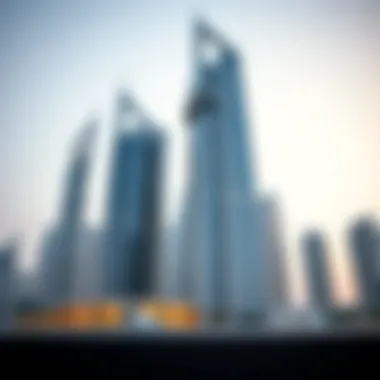
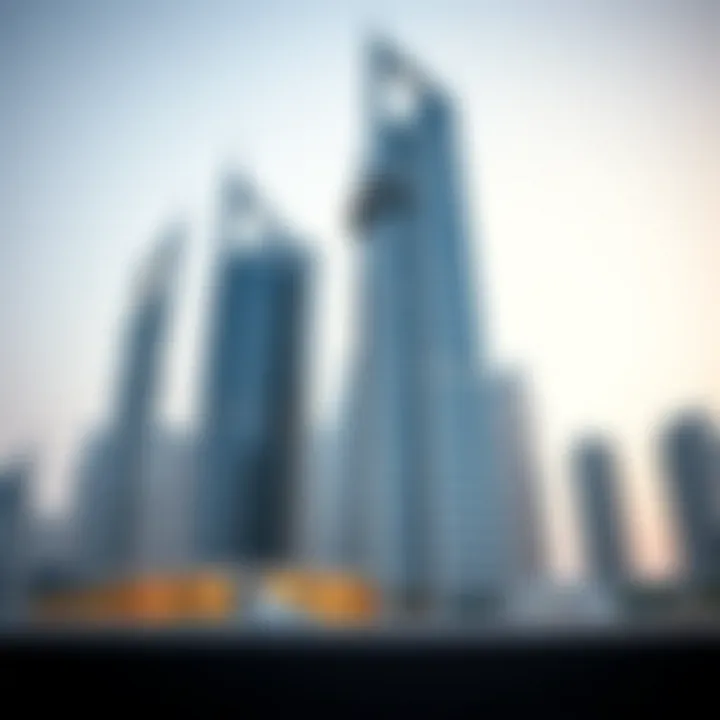
Palm Jumeirah
Palm Jumeirah is one of Nakheel Properties' hallmark projects and is recognized globally for its distinct shape resembling a palm tree. This stunning man-made island is an engineering marvel, showcasing the ingenuity of Dubai in reclaiming land from the sea. The project is not just about glamour; it also symbolizes Dubai's desire to expand and redefine luxury living. With its upscale residences, luxurious hotels, and vibrant beaches, Palm Jumeirah is seen as a golden opportunity for investors.
Its unique feature lies in its layout — a trunk and fronds that offer breathtaking views of the Arabian Gulf, creating a tranquil yet opulent atmosphere. This characteristic has made it a sought-after location for expatriates, investors, and tourists alike. However, managing the environmental impact has been a concern since the inception of the project, drawing attention to the delicate balance between luxury and sustainability.
Dubai Waterfront
Dubai Waterfront is another significant undertaking by Nakheel that promises to stretch along the coast and offer unparalleled access to waterfront living. As one of the largest mixed-use developments in the world, this ambitious project aims to blend luxury residential spaces with commercial zones, recreational areas, and leisure facilities. The vibrancy of Dubai Waterfront lies in its vision — to create an integrated community where living and leisure align seamlessly.
The key characteristic of Dubai Waterfront is its diversity. It presents opportunities for various investors, from those seeking homes to commercial entities looking for retail spaces. The unique feature here is the range of amenities planned, including waterfront promenades and parks, that offer both residents and visitors a lively urban experience. On the downside, the scale of the project raises questions about its long-term sustainability and the potential strain on local resources, which are critical considerations for stakeholders in the region.
"Nakheel's developments not only reshape the skyline but also enhance the lifestyle of its residents, offering a distinctive blend of luxury and accessibility."
In summary, Nakheel Properties exemplifies how a construction firm can influence not just the architecture but the very culture of a city. As its landmark developments continue to evolve, so too does the landscape of Dubai. Investors and stakeholders will need to keep watch on Nakheel’s journey as it expands its footprint and reimagines urban living for future generations.
Binladin Group
Preface
The Binladin Group, one of the giants of the construction industry in the Middle East, has deep roots in shaping Dubai's architectural identity. Established in 1930, the highly diversified company has been instrumental in the development of numerous iconic structures throughout the region. Its long-standing reputation for quality and innovation places it among the prominent builders changing the face of Dubai. From humble beginnings, the Binladin Group has evolved into one of the leading construction firms, contributing effectively to both infrastructure and economic growth in the area.
Contributions to Dubai
The Bandalbin Group’s contributions resound throughout the city in several facets:
- Major Infrastructure Projects: The group has led significant projects such as the construction of the King Abdulaziz International Airport and the expansion of the Holy Mosque in Mecca, which underscore their capabilities in large-scale construction.
- Urban Development: In Dubai, they have played critical roles in housing developments and commercial spaces. Their work on the Dubai International Airport expansion is a testament to their excellence in urban infrastructure.
- Job Creation: The firm has generated thousands of jobs, substantially boosting the local economy. It not only employs a diverse workforce but also invests in skills training, reflecting their commitment to community welfare.
- Safety and Quality Standards: Binladin Group maintains rigorous safety and quality standards. Their emphasis on state-of-the-art construction practices has positioned them as a trustworthy player in the market.
- Cultural Impact: Their projects have added a unique flavor to Dubai's skyline, blending modern architectural techniques with traditional designs, offering a rich narrative that appeals to both residents and tourists alike.
"The Binladin Group represents a fusion of tradition and modernity, reflecting the spirit of Dubai itself."
In summary, the Binladin Group’s extensive contributions make it a cornerstone of Dubai’s construction landscape. Their industry knowledge and dedication to sustainable practices not only enhance the city's skyline but also set a benchmark for future developments. Their involvement in various high-profile projects ensures they remain a key player in shaping the city’s architectural narrative.
Sustainability in Construction
Sustainability has become more than just a buzzword in today's construction industry; it’s a necessary practice that influences how buildings are designed, constructed, and operated. In Dubai, where the rapid pace of urban development meets the desert's harsh climate, the importance of sustainable construction can't be overstated. Builders and developers are increasingly adopting green practices to not only mitigate environmental impacts but also to create spaces that enhance the quality of life for residents.
Green Building Initiatives
Green building initiatives focus on reducing carbon footprints and conserving resources. These practices encompass multiple aspects, such as energy efficiency, water conservation, waste reduction, and the use of sustainable materials. In Dubai, towers like the Burj Khalifa—the tallest building in the world—showcase these initiatives by incorporating advanced insulation systems and energy-efficient HVAC units.
Many companies are embracing leadership in energy and environmental design (LEED) certification. This ensures that projects meet strict environmental standards while promising long-term savings. For example, properties like the Dubai Design District are designed with the environment in mind, featuring ample green spaces and water features that minimize heat production.
Additionally, using recycled materials, such as crushed concrete in new fixtures, highlights an intentional move towards circular economy practices. Moreover, many builders are incorporating renewable energy systems, like solar panels, to power buildings autonomously.
Impact on Future Projects
The ongoing shift toward sustainability in construction signifies that future projects in Dubai will increasingly integrate eco-friendly practices. This trend will likely influence project funding as investors become more cautious about putting their money into developments with high environmental impacts.
Real estate agents and developers will need to pay attention to changing regulations concerning sustainability—a factor that might dictate future project designs. As residents and expatriates become more eco-conscious, it’s expected that demand will rise for properties that prioritize green features.
The landscape of Dubai's skyline will eventually reflect these priorities as more developments aim for sustainability. This isn't just about compliance; it’s about recognizing the value of building for a better tomorrow. After all, better locations with sustainable practices could command higher real estate prices, giving investors a strong incentive to adapt.
"Sustainability in construction isn't just about environmental impact—it's about economic sense and enhancing living standards for everyone."
Investors and stakeholders would do well to keep their fingers on the pulse of this trend. With these green building initiatives shaping the future of Dubai's construction landscape, the focus will likely shift from mere aesthetic value towards creating a lasting legacy through responsible development.
By being at the forefront of these changes and adapting to trends, builders and investors can ensure that they not only contribute to shaping the skyline but also nurture a sustainable environment for generations to come.
For further insights, one can explore resources on sustainable architecture and urban planning at Britannica or Wikipedia.
Technological Innovations
The construction sector in Dubai is not just about bricks and mortar. It's about how builders integrate cutting-edge technology into every phase of their projects. These innovations play a pivotal role in enhancing efficiency, reducing waste, and pushing the boundaries of design. Technological advancements also position Dubai as a leader in adopting modern practices, setting higher standards for future developments. By leveraging these tools and techniques, builders can respond to the fast-paced demands of the real estate market.
Use of Advanced Materials
As the skyline of Dubai evolves, so does the demand for materials that can endure the test of time while maintaining aesthetic appeal. Advanced materials are designed to meet these challenges. With options ranging from energy-efficient insulation to high-performance glass, builders are now able to create structures that are not only visually striking but also environmentally sound. The use of these materials can significantly lower energy costs, making them increasingly popular among developers and investors alike.
Some examples include:
- Self-healing concrete: A blend that repairs its own cracks, extending building lifespan.
- Aerogel insulation: This super lightweight yet effective material ensures minimal heat transfer, enhancing energy efficiency.
These materials are becoming central to discussions about sustainability and resilience in structural design.
Construction Techniques
Modular Construction
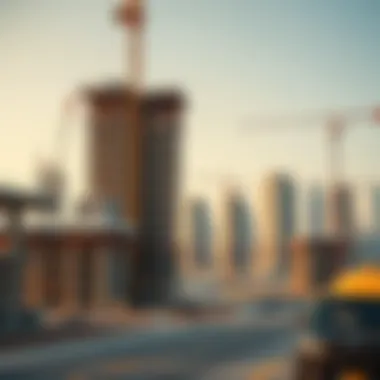
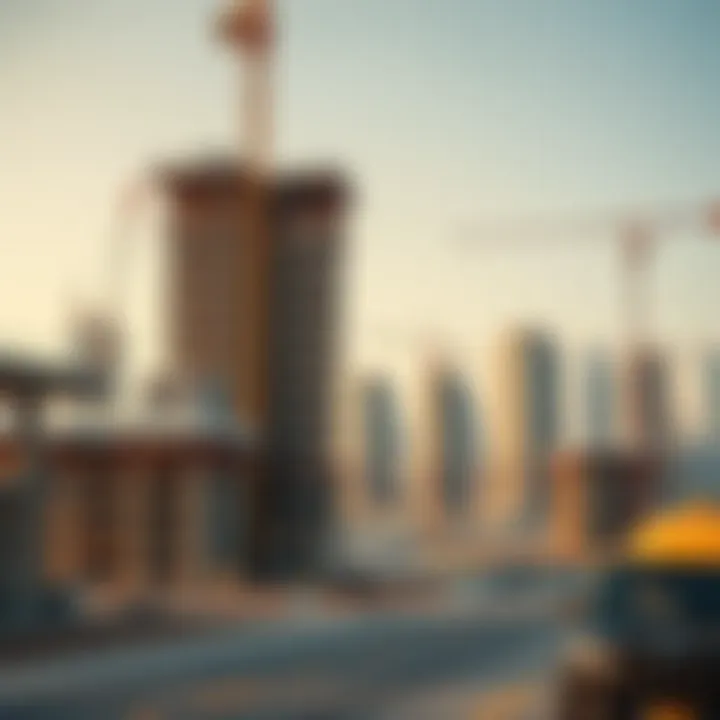
Modular construction is a game-changer in the way buildings are conceived and executed. This approach involves creating sections of a structure offsite and then assembling them at the final location. One significant aspect is its speed — projects that might take months can be completed in a fraction of the time. This time efficiency allows for faster revenue generation for developers, which is certainly attractive in a buzzing market like Dubai.
A key characteristic of modular construction is its versatility. Builders can design adaptable spaces that can be reconfigured as needs change. However, there are potential drawbacks, such as quality control challenges and limited customization options in some cases.
This method's unique feature lies in its prefabrication aspect, which often results in less waste and a cleaner worksite. In the context of this article, the efficiency and eco-friendliness of modular construction cannot be overstated, making it an appealing option for future developments in Dubai's ever-growing skyline.
3D Printing
3D printing technology is also beginning to find its place in the construction sphere, with a particular focus on small structures and components. This technique allows builders to create intricate designs that traditional methods may not easily achieve. What makes 3D printing particularly intriguing is its potential for minimizing labor costs and waste. By producing materials and components layer by layer, builders can significantly reduce excess, offering a more sustainable approach to construction.
A defining characteristic is the precision it offers. Builders can execute designs with high accuracy, which can lead to superior final products. Yet, it's worth noting that while 3D printing offers many advantages, the technology is still relatively new in terms of large-scale applications and might face regulatory hurdles.
Overall, both modular construction and 3D printing highlight the ongoing evolution of the building sector in Dubai, pushing the boundaries of what is possible and offering insights into the future landscape of urban development.
"Technological advancements are not merely tools for construction; they represent a paradigm shift in how we envision our cities for generations to come."
For further reading on the subjects of modular construction and 3D printing, you can explore additional resources from Wikipedia and Britannica.
By embracing these innovations, the builders of Dubai not only enhance their operational efficiencies but also contribute to a sustainable architectural future.
Market Trends and Forecast
Understanding the market trends and forecasts in Dubai's construction sector is like looking through a crystal ball for investors and stakeholders. It's all about spotting the patterns, deciphering economic signals, and positioning oneself for future opportunities. This section will dive into the current landscape and what lies ahead, painting a clear picture for real estate agents, investors, expatriates, homeowners, and developers.
Current Market Landscape
As of late 2023, Dubai's real estate market is showing a remarkable resilience, buoyed by a mix of domestic and foreign investments. The demand for residential properties remains strong, driven by an influx of expatriates seeking housing. Prices have edged upwards, and luxury properties are thriving, partly because of robust tourism and the global events hosted in the city. Property types that are particularly heating up right now include:
- Villas and townhouses: These have become increasingly popular among families who seek more space.
- Luxury apartments: Places like the Dubai Marina and Downtown Dubai are consistently in high demand.
- Off-plan projects: Many buyers are enticed by the potential for capital appreciation in new developments.
Factors such as government initiatives aimed at long-term residency and the World Expo 2020 (which extended its effects into subsequent years) have further invigorated the sector. Overall, while there may be fluctuations, the market is characterized by high liquidity and competitive dynamics that suggest it isn’t cooling off any time soon.
Predictions for Development
Forecasting the trajectory of Dubai's construction industry involves considering a multitude of elements, such as economic indicators, government policies, and consumer preferences. Analysts are optimistic that the real estate market will continue to thrive, with several important trends expected:
- Sustainable Development Practices: There's a growing emphasis on green buildings, reflecting global concerns about climate change. Developers are likely to invest in energy-efficient technologies and sustainable materials.
- Technological Integration: The adoption of new technologies including smart home systems and construction innovation like 3D printing is set to reshape not just the buildings themselves but the overall market approach.
- Expansion into Emerging Areas: Areas outside of the traditional hotspots are likely to see new developments as infrastructure improves. Areas like Dubai South and even parts of Sharjah may draw investment thanks to better transportation links.
- Changing Buyer Preferences: The pandemic has shifted desires, with more individuals seeking homes that provide spaces for remote working. Developers need to pay attention to these shifts and adapt their offerings accordingly.
To sum it up, those in the market would do well to keep their ear to the ground.
"The construction industry in Dubai isn't just about building structures, it's about building the future. Being attuned to market trends can help investors make wise choices that align with what tomorrow demands."
Providing a keen awareness of local and global trends will equip stakeholders with the insight needed to not just survive but thrive in this ever-evolving landscape. Keep your eyes peeled and stay informed, as the future for Dubai's skyline seems not just bright but truly transformative.
Investment Opportunities
In the bustling landscape of Dubai’s real estate market, understanding investment opportunities is paramount for anyone looking to tap into potential profits. The current economic climate in Dubai, bolstered by tourism, trade, and a growing population, creates a fertile ground for investments that promise significant returns.
Emerging Areas
When we talk about emerging areas, several neighborhoods are sprouting with promise. Areas like Dubai South are seeing a surge in interest, mainly due to the expansion of the Al Maktoum International Airport and the Expo 2020 legacy projects. Moreover, Dubai Creek Harbour is another hot spot. Planned to include a mix of residential, commercial, and leisure spaces, this area aims to be the centerpiece of Dubai's future.
Another notable mention is Mohammed Bin Rashid City. With its luxury amenities and proximity to key attractions, it draws both expatriates and locals looking for a high-end living experience. Investors should keep an eye on these regions as they have the potential for capital appreciation and rental yields.
Risks and Considerations
Before diving headfirst into investments, it’s vital to be aware of the risks and considerations that come with the territory. One of the primary concerns is the market volatility. Depending on global economic conditions, property values can fluctuate, leading to unexpected challenges.
Another aspect worth considering is regulatory changes. The real estate sector in Dubai has undergone many adjustments, adding to the complexity for investors. Being well-versed in the legalities and ensuring compliance with local regulations is crucial.
Additionally, it's essential to think about the long-term sustainability of certain areas. As property development continues at a dizzying pace, distinguishing between genuine embedded value and speculative hype can be tricky.
In summary, while Dubai presents a cornucopia of investment opportunities, diligence and informed decision-making hold the keys to success in this ever-evolving market.
End
The construction boom in Dubai is much more than mere bricks and mortar; it's a reflection of the city's aspirations and an embodiment of its future. As we've seen throughout this article, the prominent builders shaping the skyline of Dubai play a crucial role in not only developing iconic structures but also in steering the broader economic growth of the region.
Importance of Key Builders
These builders, such as Emaar Properties, Dubai Holding, Aldar Properties, Nakheel, and the Binladin Group, are pivotal in translating ambitious visions into concrete realities. Their contributions transcend aesthetics, influencing real estate dynamics, urban planning, and community development.
- Investment Attraction: The towering skyscrapers and luxury developments serve as magnets for investment, drawing in expatriates, global investors, and homeowners eager to stake their claim in a vibrant market.
- Economic Growth: Each project undertaken not only adds to the skyline but also fuels job creation and stimulates surrounding businesses.
- Sustainability Practices: Builders are progressively integrating sustainable practices into their operations, which is vital for long-term viability in an ecologically sensitive region.
Final Thoughts
The implications go beyond the immediate allure of tall buildings. The work of these builders lays the groundwork for a sustainable and economically viable future. As Dubai continues evolving, so too will its architectural landscape, driven by innovation and a commitment to excellence.
In summation, the builders of Dubai are not just shaping skylines; they are shaping the very essence of what the city represents—an ambitious blend of tradition and modernity, a hub where East meets West. To fully leverage the opportunities present in Dubai’s real estate market, stakeholders must appreciate the intricate relationship between these prominent builders and the city's growth trajectory.
“Buildings are a product of their times; they whisper to us the stories of their creators.”
Investors, real estate agents, and homeowners must keep their finger on the pulse of this dynamic sector to unlock benefits that extend far beyond property ownership. Paying heed to the ongoing trends and developments allows one to tap into the potential of a region that offers endless possibilities.




